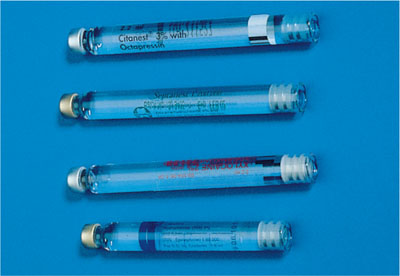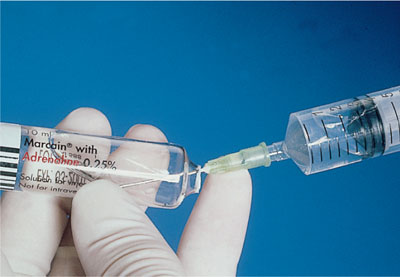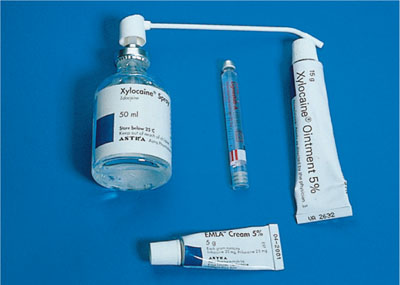Chapter 3
Local Anaesthetic Drugs
Aim
The aim of this chapter is to describe the drugs that are used during dental local anaesthesia.
Outcome
After reading this chapter you should have an understanding of the drugs used in dental local anaesthesia and be able to determine the most appropriate choice for particular treatments in individual patients.
Introduction and Terminology
Two classes of drugs are encountered during dental local anaesthesia. These are the anaesthetic agents and vasoconstrictors. Various combinations are available in the UK in dental cartridges (Table 3-1).
| Vasoconstrictor-free | With epinephrine | With felypressin | |
| Local anaesthetic | |||
| Lidocaine | + | + | |
| Prilocaine | + | + | |
| Mepivacaine | + | + | |
| Articaine | + |
+ = combination available
Local anaesthetic drugs are classified by their chemical structure. Two types are used:
-
amides
-
esters.
Similarly, vasoconstrictors are classified into two groups. These are:
-
catecholamines
-
synthetic polypeptides.
In addition to the anaesthetic agent and the vasoconstrictor, the local anaesthetic solution contains other ingredients. As well as the solvent, which is Ringer’s solution, epinephrine- (adrenaline-)containing solutions include a reducing agent to prevent loss of properties of the catecholamine. Previously, local anaesthetics had preservatives such as para-amino-benzoic acid included. These days most solutions are preservative-free.
Amide Local Anaesthetics
The amide local anaesthetics that may be used in dentistry in the UK are:
-
lidocaine (lignocaine)
-
prilocaine
-
mepivacaine
-
articaine
-
bupivacaine and levobupivacaine
-
ropivacaine.
These are the approved non-proprietary names of the agents. Table 3-2 relates proprietary names to the approved version. At the time of writing, only the first four were available in dental local anaesthetic cartridges in the UK (Fig 3-1). Bupivacaine, levobupivacaine and ropivacaine anaesthetic solutions are supplied in standard hospital type vials. Therefore, they must be “drawn up” (Fig 3-2).
| Proprietary name | Approved name |
| Chirocaine | Levobupivacaine |
| Citanest | Prilocaine |
| Lignospan | Lidocaine |
| Lignostab | Lidocaine |
| Marcain | Bupivacaine |
| Naropin | Ropivacaine |
| Scandonest | Mepivacaine |
| Septanest | Articaine |
| Xylocaine | Lidocaine |
| Xylotox | Lidocaine |

Fig 3-1 Some of the different types of cartridges of dental local anaesthetics available in the UK.

Fig 3-2 Some local anaesthetics are unavailable in cartridges in the UK and therefore must be drawn up from vials.
The amide anaesthetics are the group almost exclusively used for injection in modern dentistry. In addition to having physicochemical properties, which confer a better anaesthetic profile than the esters, an important attribute of the amide group is the low potential for producing allergic reactions. Ester local anaesthetics are more likely to induce allergy.
Lidocaine
Lidocaine is the “gold standard” local anaesthetic drug. It has been used in dental anaesthesia for over 50 years (Fig 3-3). When used for injection in dentistry it is provided as a 2% solution (20 mg/mL). Like all the other injectable agents described it is dissolved in solution as the hydrochloride salt. When used as a topical anaesthetic, a number of formulations and concentrations have been employed – for example, a 5% gel, a 10% spray or up to 20% incorporated into an adhesive patch.

Fig 3-3 Lidocaine is available in a number of formulations for injection and topical use.
Lidocaine, when used alone, does not provide long-lasting pulpal anaesthesia. When combined with epinephrine, reliable dental anaesthesia is achieved after injection by any of the standard methods described later in this book. The plain solution can provide soft tissue anaesthesia, although the duration is less than that obtained when a vasoconstrictor is included in the formulation. In the UK 2% lidocaine is normally combined with epinephrine in a concentration of 1:80,000 (12.5μg/mL). When used in infiltration and regional block anaesthesia, lidocaine with epinephrine can produce pulpal anaesthesia of about 45 minutes. Soft tissue anaesthesia lasts longer and altered soft tissue sensation may be present for 2 to 3 hour/>
Stay updated, free dental videos. Join our Telegram channel

VIDEdental - Online dental courses


